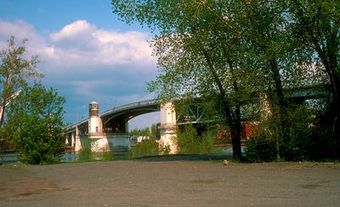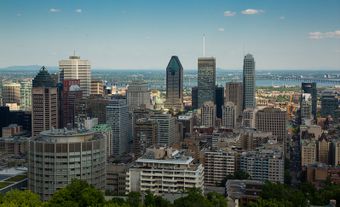The Town of Mount Royal (Ville de Mont-Royal in French, also known by its English-language initials TMR), Quebec, founded 1912, population 20,953 (2021 census), 20,276 (2016 census). The Town of Mount-Royal is a planned community located on the island of Montreal, located northwest of the small mountain for which it is named (Mount Royal). It is an affluent and independent suburb entirely encircled by the city of Montreal. It is an excellent example of the garden city model city concept popular in the early 20th century. The community was created to finance the construction of the Mount Royal Tunnel, a railway tunnel that allowed the Canadian Northern Railway to access downtown Montreal.
Location and Geography
The Town of Mount Royal is an irregularly shaped community surrounded by the city of Montreal. It consists of two distinct sections, one primarily industrial and the other primarily residential. The original community was roughly rectangular, with three main arterial roads (Laird, Graham and Canora) meeting in the middle. The layout of Washington, D.C. influenced its overall design. The centre of the community contains most of its businesses and commercial establishments, as well as the civic infrastructure (including the town hall, arena, library, several places of worship, and schools). Though the community is named after Mount Royal, it is not part of the mountain domain—an area designated by the city of Montreal and the government of Quebec where new development is limited and the natural, cultural and institutional aspects of Mount Royal are preserved. The community is located on Mount Royal’s northwestern slope, several kilometres from Mount Royal Park.

History
Like the rest of Montreal Island, the area now referred to as the Town of Mount Royal was likely inhabited by Iroquoian-speaking Indigenous people in the centuries before European colonization. Located on the opposite side of Mount Royal from the St. Lawrence River, it was not part of the original settlements that led to the creation of Ville-Marie. Instead, it was part of a seigneury granted to the Sulpician Order in the late 17th century. Throughout much of the 19th century, it was primarily agricultural, with the community only formally incorporated in 1912.
The community's foundation was directly related to the Canadian Northern Railway's construction of the Mount Royal Tunnel. The idea was to create a model city based on the Garden City and City Beautiful concepts popular in the early 20th century. The sale of property in this new community would offset the cost of constructing the tunnel. The model city would be focused on the northern portal to the tunnel, allowing it to become one of Montreal’s first modern bedroom communities.
The Town of Mount Royal was developed in response to concerns about urban development in the late 19th century, demonstrating the theories of urban renewal in vogue at the time. In response to the rapid industrialization and population density growth in Montreal, the Town of Mount Royal was planned with lower density in mind, an abundance of public spaces, wide tree-lined streets and a centrally located train station to support its commuter population. These design elements have been preserved throughout the community’s history.
The project was launched in 1910 under the direction of Canadian Northern Railway’s owners, Sir William Mackenzie and Sir Donald Mann, with the assistance of their chief engineer, Henry K. Wicksteed. Frederick Gage Todd, the prominent landscape architect, was tasked with developing a master plan. The community’s development has adhered to Todd’s plan and vision through the years. The town was formally incorporated in December 1912 as work proceeded on excavating the tunnel. When the tunnel was completed in 1918, the first train service to downtown Montreal was established. The town developed in three distinct phases, each lasting roughly 20 years and concluding, for the most part, around 1975.
The Town of Mount Royal was briefly amalgamated into the rest of the city of Montreal from 2002 to 2006 when it was re-constituted as an independent community following the Quebec municipal demerger referendum in 2004.
The Town of Mount Royal was designated a National Historic Site of Canada in 2008 in recognition of its unique characteristics, which synthesize several important movements in urban design from the early 20th century, and also in recognition of its integrity in maintaining these characteristics.
The western portion of the town is a large industrial park located at the intersection of Highways 15 and 40. A portion of this area is being redeveloped as a large multi-use residential and commercial complex called Royalmount.
Did you know?
The western slope of Mount Royal, including the area in which the Town of Mount Royal was built, was primarily agricultural until the early 20th century. This area's fertile soil and unique microclimate allowed the Montreal Market Melon, also known as the Montreal Nutmeg Melon, to be grown. Melons were brought over by French colonists and crossbred with other varieties over the centuries, creating a unique fruit well known for its large size, distinct flavour and delicious flesh. The Montreal Melon was considered a delicacy and sold for a high price, but it could also be difficult to grow. As agriculture disappeared from Montreal Island during the latter half of the 20th century, so did the once-famous melon. The development of the Town of Mount Royal as a residential suburb destroyed some of the prime growing land for the melon. Though it was thought to be extinct, Montreal Market Melon seeds were found in an Iowa seed bank in 1995 and the melon has since been revived.

Model City of Mount Royal National Historic Site of Canada
The government of Canada recognized the original Town of Mount Royal as a national historic site in 2008. There were many reasons for this recognition, though most related to the town’s architectural heritage value. The Town of Mount Royal uniquely blends several distinct urban planning concepts from the early 20th century, including the Garden City, Urban Park, City Beautiful and Garden Suburb movements. It was also recognized as an excellent demonstration of railways' role in speculative real estate development. The community’s historic status also recognizes that its gradual development over the middle decades of the 20th century further illustrates the evolution of residential urban planning and the impact and influence of landscape architects.

 Share on Facebook
Share on Facebook Share on X
Share on X Share by Email
Share by Email Share on Google Classroom
Share on Google Classroom



